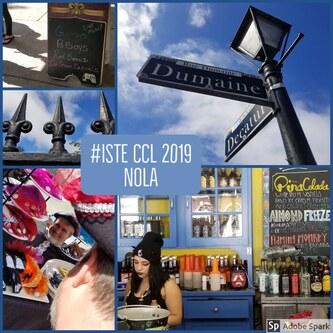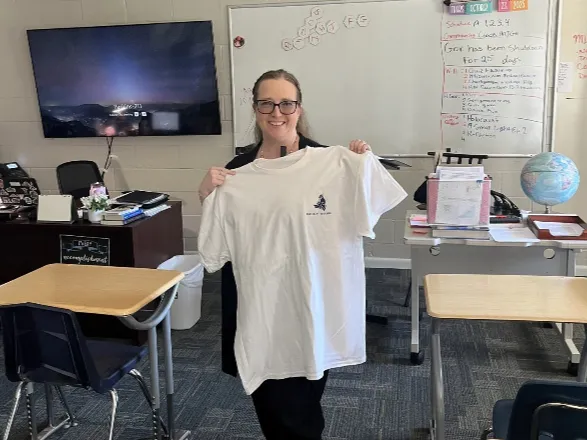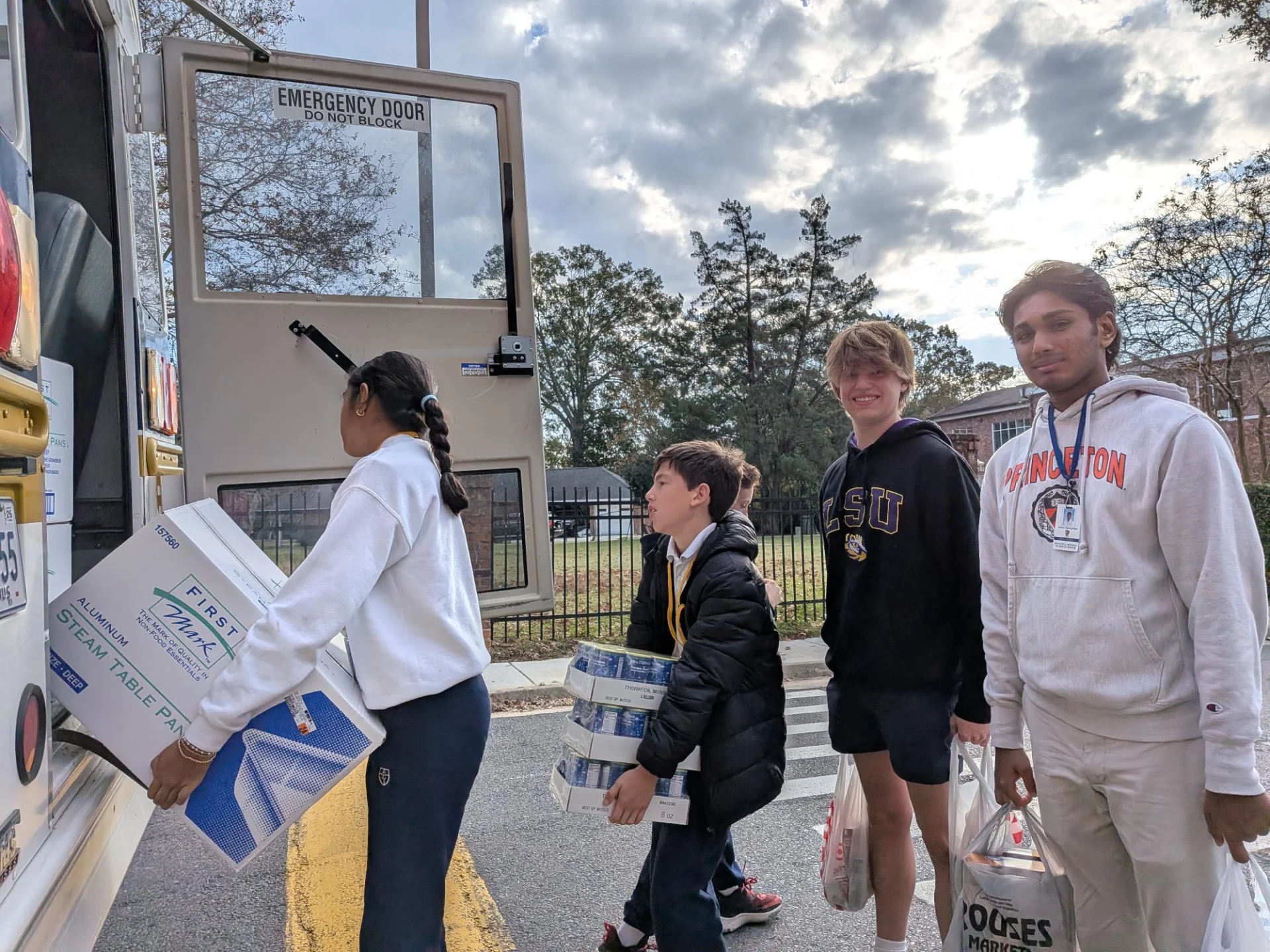- Admission
- Discover Episcopal
- Our Program
- Athletics
- Arts
- Spirituality
- Student Life
- Support Episcopal
- Alumni
- Parent Support
- Knightly News
- Contact Us
- Calendar
- School Store
- Lunch Menu
« Back
 The ISTE Creative Constructor Lab, held in New Orleans this year, is “an interactive learning experience that uncovers how to create vibrant, media-rich learning environments to help grow the next generation of creators,” according to their “about” page. Really, though, it was an opportunity for educators to play with media and design in order to better help our students learn to create. Some of the sessions we experienced included spontaneous construction with index cards, being let loose in the French Market after a crash-course on photography and videography with the charge to “create a piece that displays how New Orleans looks, moves, sounds, smells, and tastes,” making masks with lights and circuits, learning how to podcast, constructing stop-motion animations, experiencing virtual reality flying and augmented reality games, and working together to design solutions to a problem.
The ISTE Creative Constructor Lab, held in New Orleans this year, is “an interactive learning experience that uncovers how to create vibrant, media-rich learning environments to help grow the next generation of creators,” according to their “about” page. Really, though, it was an opportunity for educators to play with media and design in order to better help our students learn to create. Some of the sessions we experienced included spontaneous construction with index cards, being let loose in the French Market after a crash-course on photography and videography with the charge to “create a piece that displays how New Orleans looks, moves, sounds, smells, and tastes,” making masks with lights and circuits, learning how to podcast, constructing stop-motion animations, experiencing virtual reality flying and augmented reality games, and working together to design solutions to a problem.
Episcopal Teachers Model Lifelong Learning for Their Students
December 12th, 2019

I love learning. In fact, I think that’s one of the reasons I couldn’t do anything but teach if I wanted to because there’s so many opportunities to continue to learn and grow each year, right alongside my students. I enjoy any chance I have for professional or personal development to help make my classroom the best learning environment for my students. That’s why, when I was able to attend the ISTE (International Society for Technology in Education) Creative Constructor Lab in October of this year with my colleagues Betsy Minton, Stacy Hill, and Rosalyn Won, I jumped at the chance.
A Conference Recap
 The ISTE Creative Constructor Lab, held in New Orleans this year, is “an interactive learning experience that uncovers how to create vibrant, media-rich learning environments to help grow the next generation of creators,” according to their “about” page. Really, though, it was an opportunity for educators to play with media and design in order to better help our students learn to create. Some of the sessions we experienced included spontaneous construction with index cards, being let loose in the French Market after a crash-course on photography and videography with the charge to “create a piece that displays how New Orleans looks, moves, sounds, smells, and tastes,” making masks with lights and circuits, learning how to podcast, constructing stop-motion animations, experiencing virtual reality flying and augmented reality games, and working together to design solutions to a problem.
The ISTE Creative Constructor Lab, held in New Orleans this year, is “an interactive learning experience that uncovers how to create vibrant, media-rich learning environments to help grow the next generation of creators,” according to their “about” page. Really, though, it was an opportunity for educators to play with media and design in order to better help our students learn to create. Some of the sessions we experienced included spontaneous construction with index cards, being let loose in the French Market after a crash-course on photography and videography with the charge to “create a piece that displays how New Orleans looks, moves, sounds, smells, and tastes,” making masks with lights and circuits, learning how to podcast, constructing stop-motion animations, experiencing virtual reality flying and augmented reality games, and working together to design solutions to a problem.The most important thing I took away from the conference was the idea that integrating more design thinking into my classes will better serve my students, for multiple reasons. Besides the fact that it can be a fun way to learn and can help students explore their interests, design thinking has been shown to provide a host of benefits for students. From allowing more opportunities for them to develop empathy when viewing problems they need to solve from different perspectives, to challenging them to hack existing models and systems, to permitting them the opportunity to solve problems in creative and innovative ways. Design thinking also allows students to think more divergently, create connections between subjects (and also with the “real world”), and take creative risks. The method of several prototypes, revisions, and reflections expands their knowledge because they sometimes have to explore a topic more in depth to be able to create what they want, contributing to their practical, life and career skills. While it doesn’t always work for every project in every subject, it can certainly be incorporated from time to time.
Connections to Design Studio
 Episcopal is already familiar with these benefits, which is why we have the Design Studio (initially created in conjunction with our NuVuX program) and the courses connected with it. Often, design thinking is more closely associated with STEM courses, simply by virtue of those fields attempting to create problem-solving designs. For example, our first round of design studio courses involved designing assistive devices for children with developmental disorders, outfitting sports equipment to prevent injury, identifying ways to assist people still recovering from the 2016 flood, and developing a better method for safely harvesting community fruit in Baton Rouge as part of the City Citrus program. All of these are very practical and often very closely tied with engineering. However, design thinking can also lend itself to humanities courses and is already an important part of the arts. For example, last year, English teachers Kealy Duke and Karin DeGravelles taught courses on Neuroplasticity and Communication and Writing to Influence, respectively. I’m currently teaching one on Multisensory Storytelling in which students are thinking about the role stories play in our everyday lives and how we can enhance stories to allow audiences to experience them more fully. Between teaching this course and my time at the conference, I’ve become convinced in our need to incorporate design thinking into more aspects of my classes. Enter the Maker Kitchen.
Episcopal is already familiar with these benefits, which is why we have the Design Studio (initially created in conjunction with our NuVuX program) and the courses connected with it. Often, design thinking is more closely associated with STEM courses, simply by virtue of those fields attempting to create problem-solving designs. For example, our first round of design studio courses involved designing assistive devices for children with developmental disorders, outfitting sports equipment to prevent injury, identifying ways to assist people still recovering from the 2016 flood, and developing a better method for safely harvesting community fruit in Baton Rouge as part of the City Citrus program. All of these are very practical and often very closely tied with engineering. However, design thinking can also lend itself to humanities courses and is already an important part of the arts. For example, last year, English teachers Kealy Duke and Karin DeGravelles taught courses on Neuroplasticity and Communication and Writing to Influence, respectively. I’m currently teaching one on Multisensory Storytelling in which students are thinking about the role stories play in our everyday lives and how we can enhance stories to allow audiences to experience them more fully. Between teaching this course and my time at the conference, I’ve become convinced in our need to incorporate design thinking into more aspects of my classes. Enter the Maker Kitchen.

Maker Kitchen
I wanted to share one particularly helpful session with my colleagues that speaker and educator Kenneth Shelton led at the conference titled “Maker Kitchen.” The activity is designed much like the television show “Chopped,” where contestants are required to cook specific types of meals under a time limit. They may use a fully stocked pantry to supplement their dishes, but they must use all the ingredients provided in their baskets whether they include kale or pickled pigs feet.
For our activity, Upper School faculty were divided into two sets each of groups A, B, and C. The goal was for each group to “use the supplies provided to create a project that provides the viewer with a sense of the subject matter and which will give a sense of the story of the purpose of the project.” However, in order to demonstrate the types of limits that some schools experience (and also to foster creativity out of necessity) the following rules applied within the thirty-minute time limit:
For our activity, Upper School faculty were divided into two sets each of groups A, B, and C. The goal was for each group to “use the supplies provided to create a project that provides the viewer with a sense of the subject matter and which will give a sense of the story of the purpose of the project.” However, in order to demonstrate the types of limits that some schools experience (and also to foster creativity out of necessity) the following rules applied within the thirty-minute time limit:
- Groups MUST use all of the supplies provided in their bag. (A motor, two AA batteries, a switch, wires, and a miniature pie tin.)
- Groups may supplement their project with the items in the “pantry.”
- Those in GROUP A have no restrictions to the pantry or technology.
- Those in GROUP B may NOT use technology and may only use TEN items from the pantry. They may only visit the pantry ONCE.
- Those in GROUP C may NOT use technology, may only use FIVE items from the pantry, may only visit the pantry ONCE. That trip will be after everyone else goes and will only last for THREE minutes.
- They had 30 MINUTES to complete their project.



Takeaways
At the end of our adventure, we had quite an array of projects – from an interpretive art piece that brought a monster to life to an airplane that took off from a paper bag runway to a windmill to a commentary on the pollution of our waterways. There was a lot of creative problem-solving, collaboration, cross-curricular work, re-purposing of items beyond what they were originally intended for, and chances for people to display skills they may not normally get the opportunity to.
There was also a lot of laughter. And some competitiveness. One A group considered taking everything from the pantry to prevent the others from having access to the items, though they decided to be good sports in the end. One C group initially attempted completing their project without any items from the pantry, but decided to relent and chose their five items wisely. Both B groups were very strategic in their pantry choices, with one group spending quite some time in terse negotiation.
Overall, the feedback I received from my colleagues was that they’d like to brainstorm ways to incorporate more design thinking into their own classrooms if they don’t already do so. I also believe that they now see it as a much more accessible tool on a daily basis rather than having to take a trip to the actual Design Studio and knowing how to use the 3-D printer or the laser cutter. Scissors and some felt or cardboard work just as well. But the most important takeaway? Learning can always be playful.
There was also a lot of laughter. And some competitiveness. One A group considered taking everything from the pantry to prevent the others from having access to the items, though they decided to be good sports in the end. One C group initially attempted completing their project without any items from the pantry, but decided to relent and chose their five items wisely. Both B groups were very strategic in their pantry choices, with one group spending quite some time in terse negotiation.
Overall, the feedback I received from my colleagues was that they’d like to brainstorm ways to incorporate more design thinking into their own classrooms if they don’t already do so. I also believe that they now see it as a much more accessible tool on a daily basis rather than having to take a trip to the actual Design Studio and knowing how to use the 3-D printer or the laser cutter. Scissors and some felt or cardboard work just as well. But the most important takeaway? Learning can always be playful.
Lisa Pritchard has been a member of the English Department at Episcopal since 2015 and attempts to foster the same love of reading and writing in her students that she gained from her own teachers. Previously, she lived and worked at her alma mater, the Buffalo Seminary, as English Department Chair and a residential house director where she had the opportunity to play house mom to interesting students from around the world. She earned her Master of Arts degree in English at the University of Buffalo and her Bachelor of Arts degree in English and French at Centenary College of Louisiana.
The Episcopal School of Baton Rouge 2025-2026 application is now available! For more information on the application process, to schedule a tour, or learn more about the private school, contact us at [email protected] or 225-755-2685.
Posted in the categories All, Upper School.
Other articles to consider
 Dec12From Service to Song: Lower School Students Celebrate Christmas in Two Languages
Dec12From Service to Song: Lower School Students Celebrate Christmas in Two LanguagesEpiscopal third graders celebrated the season and French heritage with a special holiday program in the Lewis Family Memorial Chapel of the Good Shepherd.
See Details Dec11Upper School Recognizes Excellent Educators
Dec11Upper School Recognizes Excellent EducatorsThis semester, Upper School students recognized teachers who inspire, support and challenge them every day. Congratulations to our Excellent Educator honorees.
See Details Dec11Smashing Goals, Building Community: Episcopal’s Shepherd’s Market Food Drive Success
Dec11Smashing Goals, Building Community: Episcopal’s Shepherd’s Market Food Drive SuccessThe Episcopal Shepherd’s Market Food Pantry “Great Turkey Giveaway” food drive broke records. We’re proud of our students and families for building community through service.
See Details Dec4Sixth Grade Care Packages Build Community and Bridge Generations
Dec4Sixth Grade Care Packages Build Community and Bridge GenerationsEpiscopal sixth graders shared holiday cheer by sending care packages to members of the Class of 2025. A tradition that proves once a Knight, always a Knight! Plus, learn more about upcoming alumni holiday events.
See Details
Categories
- All
- Admission
- Athletics
- College Bound 2019
- College Bound 2020
- College Bound 2021
- College Bound 2022
- College Bound 2023
- College Bound 2024
- College Bound 2025
- Counselors Corner
- Episcopal Alumni
- Giving
- Head Of School
- Lower School
- Middle School
- Spirituality And Service
- Student Work
- The Teachers' Lounge
- Upper School
- Visual And Performing Arts
Recent Articles
- 12/12/25From Service to Song: Lower School Students Celebrate Christmas in Two Languages
- 12/11/25Upper School Recognizes Excellent Educators
- 12/11/25Smashing Goals, Building Community: Episcopal’s Shepherd’s Market Food Drive Success
- 12/4/25Sixth Grade Care Packages Build Community and Bridge Generations
- 12/3/25What is Project Based Learning?
- 12/2/25Celebrating the Season with Student Art
- 12/2/25Christmas Through a Child’s Eyes by Jenny Heroman Koenig '01











